Gear Up for a Greener Future With Renewable Energy EV Charging Station
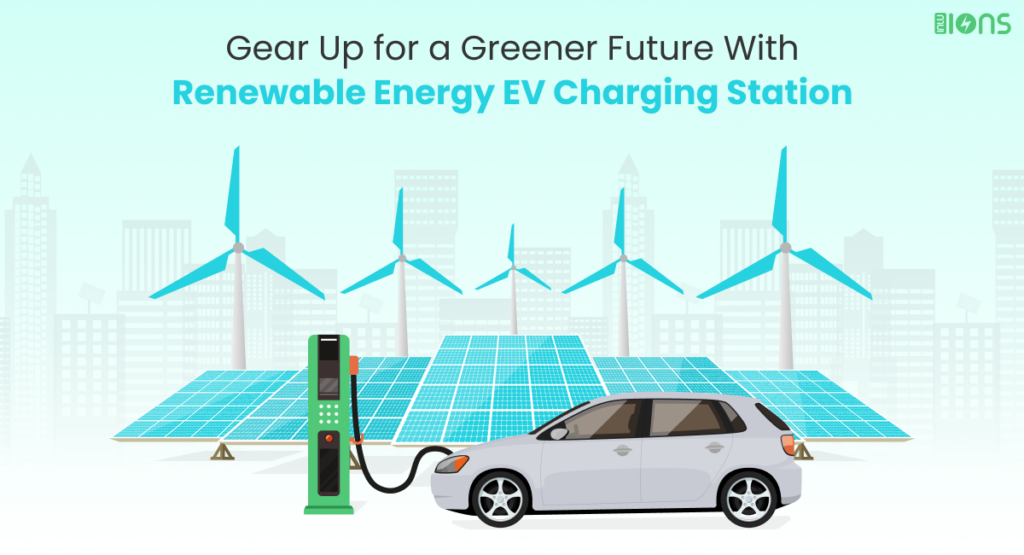
The automobile industry is undergoing a paradigm shift with the advent of the electric vehicle (EV).
Although the EVs are known for their “zero carbon emission”, this claim is not entirely true.
It is true that electric vehicles do not emit greenhouse gases from the tailpipes, but they are just as clean as the electricity that fuels them.
According to an EIA report, the CO2 emission of hydropower-intensive Washington state was 219 lbs/MWh. In contrast, in Virginia, where the power generated is mainly fossil-fueled, the CO2 emission was 649 lbs/MWh.
Renewable Energy EV Charging Station – Power up Your EVs with Green Energy
The mass shift from fossil-fueled vehicles to EVs is critical to achieving net-zero emission goals. However, with the electrification of transport, the electricity demand has also shot up.
As per a report by Morgan Lewis, the Biden-Harris administration has a stated goal of a 50% reduction in GHG emissions by 2030, combined with an ambitious 50% EV target by that same year.
While solar and wind generation is quickly growing, around 58% of electricity is generated using coal-fueled power stations.
Unless the electricity that charges the EV is clean, these vehicles can never be a completely eco-friendly option.
With a steep surge in the number of EVs, it is crucial to widely adopt renewable energy for electric vehicle charging. Combining different types of renewable energy is pivotal to reducing dependence on fossil fuels for electricity generation.
EV charging stations using renewable energy not reduce CO2 emissions, but also create a sustainable source of power.
Sustainable EV Charging – The Benefits of Using Renewable Energy
Solar panels and wind turbines are becoming a common sight. And the reasons are obvious. There are numerous benefits of renewable energies – right from less CO2 footprint to being cost-effective.
Let us see some of the benefits of using renewable power sources:
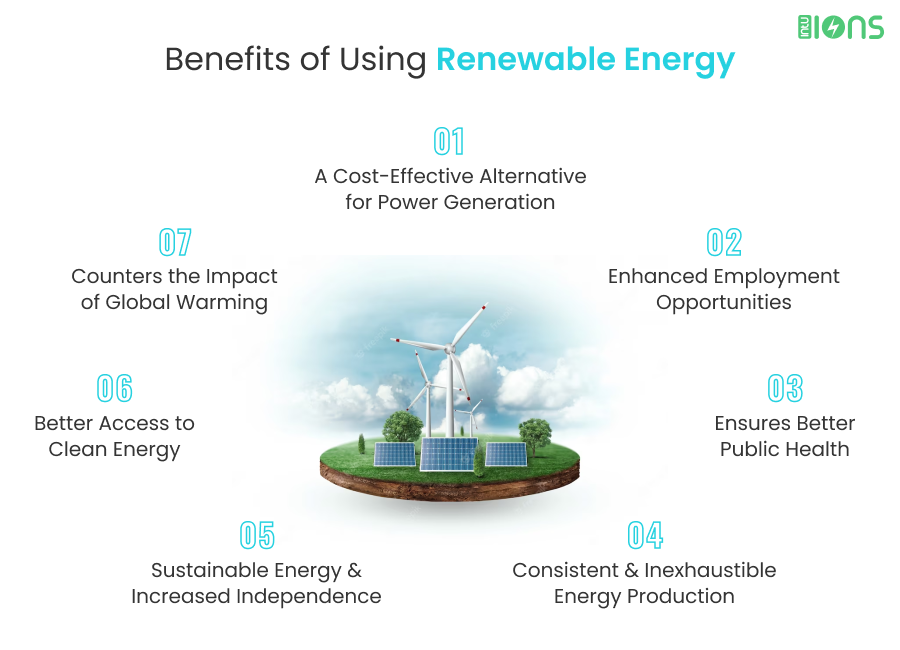
- Counters the Impact of Global Warming
Human activities are putting a strain on our climate. Rapid industrialization and modernized transportation has resulted in the emission of harmful greenhouse gases.
These gases act like an envelope that traps the earth’s heat within the atmosphere. This leads to a series of catastrophic events like frequent storms, droughts, floods, and sea-level rise.
As per an estimate, in the U.S. alone about 25% of greenhouses come from the electricity sector.
- Ensures Better Public Health
As per a report by World Health Organization (WHO), around 90 percent of the world’s population breathes air that exceeds standard air quality limits. Rising air pollution has resulted in several health hazards and is responsible for over 13 million deaths annually.
Switching to renewable sources such as wind, solar or green hydrogen will not produce harmful by-products that contaminate the air, water, or landfill.
- A Cost-Effective Alternative for Power Generation
Renewable energies are cost-effective alternatives. With technologies getting more sophisticated, the overall cost of generating power via renewable sources has dropped significantly.
Moreover, renewable energies have lower operating costs compared to fossil-fueled power generation.
For instance, constructing a solar or wind farm is a one-time investment. Renewable energy systems such as solar panels or wind turbines have a longer lifespan and come with warranties, so require little to no maintenance.
Therefore, electricity generated through renewable sources gives long-term and significant returns on investment.
- Consistent and Inexhaustible Energy Production
Sunny skies, strong gusts of winds, and forcefully-moving water are available abundantly. Thus, these sources of energy can constantly replenish the supply of electricity.
Since renewable sources are plentiful, they can provide a significant share of future electricity needs.
Moreover, these natural forces are less vulnerable to large-scale failure because these systems are disturbed and spread out over a large geographical area.
So, a severe weather condition at one location would not cause a power outage for the entire area.
- Sustainable Energy and Increased Independence
Renewable energy EV charging stations generate their electricity reducing the dependence on the power grid. This makes it possible to have a sustainable electricity supply for a fleet of EVs.
Moreover, in emergencies, such as power outages, these charging stations remain operational, as they don’t rely on the grid for electricity supply.
- Better Access to Clean Energy
One of the biggest advantages of installing a renewable energy EV charging station is better access to affordable and green electricity, even in remote areas.
Installing EV charging stations using renewable energy in public areas, workplaces, and residential complexes can make it accessible to several people. This means that anyone, irrespective of where they live, can access clean energy for charging their EVs.
- Enhanced Employment Opportunities
Traditional power plants, such as thermal or natural gas, are typically mechanized and capital-intensive.
In contrast, the renewable energy industry is labor-intensive – for instance, solar panels need skilled people for installation. Similarly, wind farms require technicians for their annual maintenance.
This means, on average, renewable power plants create more job opportunities within the local community. These figures will give you a clear picture:
- According to a report by the UN, Employment in the renewable energy sector across the world reached 12.7 million during 2021-2022. It registered a jump of 700,000 new jobs in just 12 months.
Go Green With EV Charging With These Different Types of Renewable Energy Charging Solutions
Adopting alternative and renewable energy sources is the first step toward a cleaner and sustainable future.
At present, solar and wind-powered EV charging stations are paving the path for the electrification of transportation.
Let us see different types of renewable energy EV charging stations:
1. Solar-powered EV Charging Stations
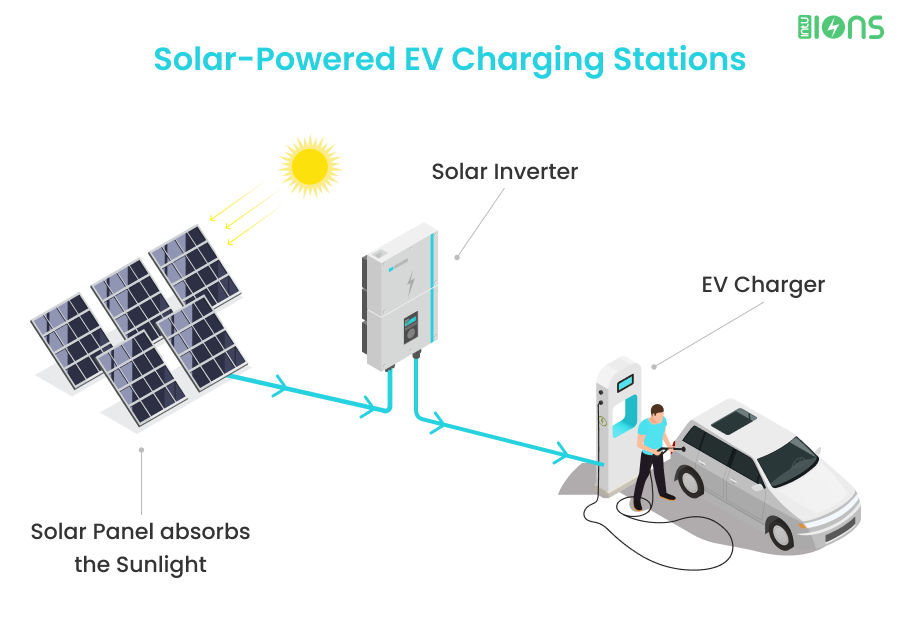
Solar-powered EV charging stations have emerged as one of the most efficient ways to reduce dependence on fossil-fueled power plants.
These charging stations use panels to convert solar power into electricity and store it in power banks. Vehicle owners can plug in their EVs to the DC charging station.
There are two types of solar-powered charging stations:
- Off-grid EV Charging Station
This type of charging station is not connected to the local grid and is known as an autonomous EV charger.
Since there is no need for an electrical grid connection, off-grid solar EV charges are easy and quick to install. Also, an EV owner can fix these panels at their home or workplace.
Here are some of the advantages of off-grid solar-powered EV charging stations:
- These stations provide reliable EV charging independent of the national grid and offer better resilience against power outages.
- Since solar panels are simple to install, they are ideal for EV charging stations in rural or remote areas.
- Off-grid solar EV charging stations provide affordable EV charging compared to the existing rates of utility upgrades, line extensions, and high-demand charges.
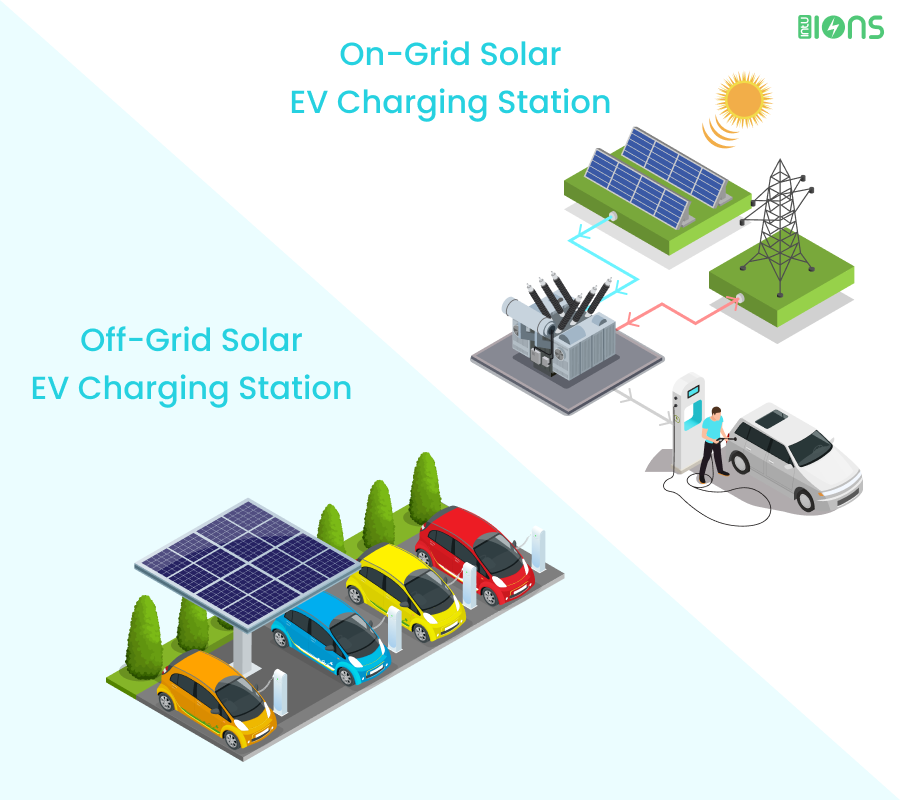
- On-grid Solar Charging Stations for EVs
The on-grid solar charging station, as the name suggests, is connected to the grid. It is one of the simplest ways to charge an EV using renewable solar power.
An on-grid solar charger keeps feeding power to the grid, even when the EV owner is at home or the workplace.
The cost of an on-grid solar EV charging station is less than an off-grid EV charger because electricity is stored in the grid and not the battery/inverter.
Moreover, when the electricity is fed back to the grid, utility companies give the owners credit, which they can use to charge the EV.
These are some of the benefits of using on-grid solar energy for EV charging:
- Economical Alternative
- Energy Self Sufficiency
- Additional Income Source (Earn money by selling extra energy back to the grid)
- Reduced Carbon Footprint
2. Wind-powered EV Charging Station
A wind-powered EV charging station harnesses the power of wind turbines to generate electricity, which can be stored in batteries or fed directly to the grid. The EV owner can plug in their vehicles to the EV charging station connected to the power grid.
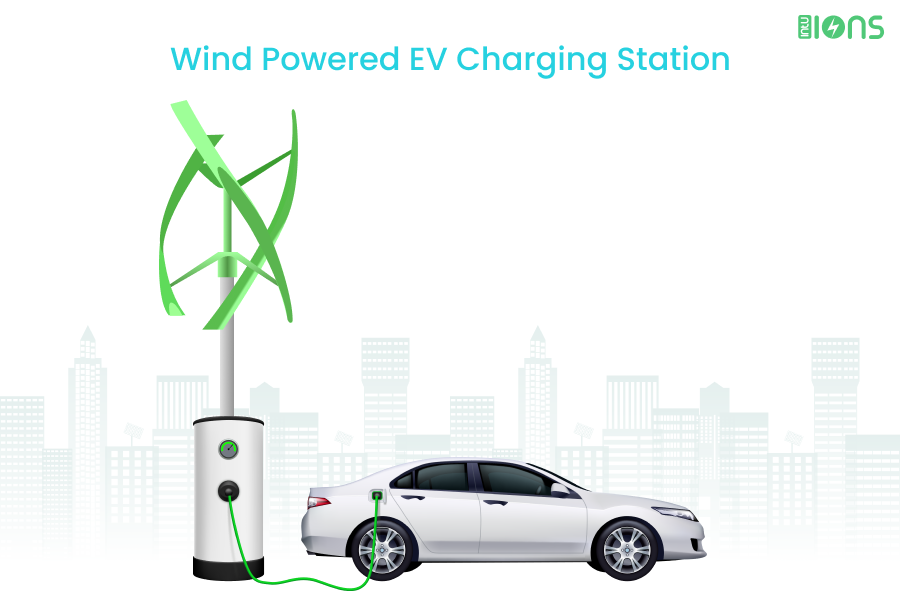
Usually, wind turbines can be installed in coastal areas – both offshore and onshore – where wind intensity is higher.
Wind-powered charging station allows EV owners to have an access to green charging infrastructure, making it easy for them to adopt EVs.
Wind-powered charging stations offer an excellent opportunity for charging EVs at night as the electricity is generated even in absence of sunlight.
Apart from providing immense environmental benefits, wind-powered EV charging stations offer a lucrative investment opportunity for OEMs. Since it is a rapidly growing area, OEMs can create a unique brand value to appeal to a large number of customers.
Additionally, some wind-powered EV charging stations are integrated with smart technology. This enables remote monitoring and maintenance of the charging station and ensures it operates efficiently.
Here are some benefits of wind-powered EV charging:
- Sustainable and Continuous Supply of Energy
- Cost-effective option as compared to traditional fuels
- Reliable Source of Energy
- Low Maintenance
There are two types of wind farms:
- Onshore Wind Farm
This type of wind farm is one of the most common and is constructed on land no less than 3 kilometers from the coast. These wind turbines mostly feed on terrestrial wind currents.
One of the major advantages of onshore wind farms is their location providing easy accessibility and proximity to the electric grid.
Onshore wind farms are ideal for EV charging stations in remote areas where the electricity grid connection is volatile.
Moreover, energy generated through wind can be scaled up or down depending on the varying requirement. This means that setting up and supporting an EV charging station even in non-urban areas becomes possible as more people start adopting EVs.
3. Hydrogen-Fueled Charging Stations for EVs
As the world is moving toward widespread vehicle electrification, hydrogen-fueled charging stations are becoming a viable energy source for EV charging. Green hydrogen and fuel cells are deployed to meet the rapidly increasing load on the grid.
Solar-Powered and Wind-Powered EV Charging Station – A Comparison
Both solar and wind-powered EV charging stations offer sustainable and cost-effective solutions. However, the choice between these two depends on factors such as:
- Location
- Weather Conditions
- Budget
- Charging Requirements
Here’s a comprehensive comparison chart:
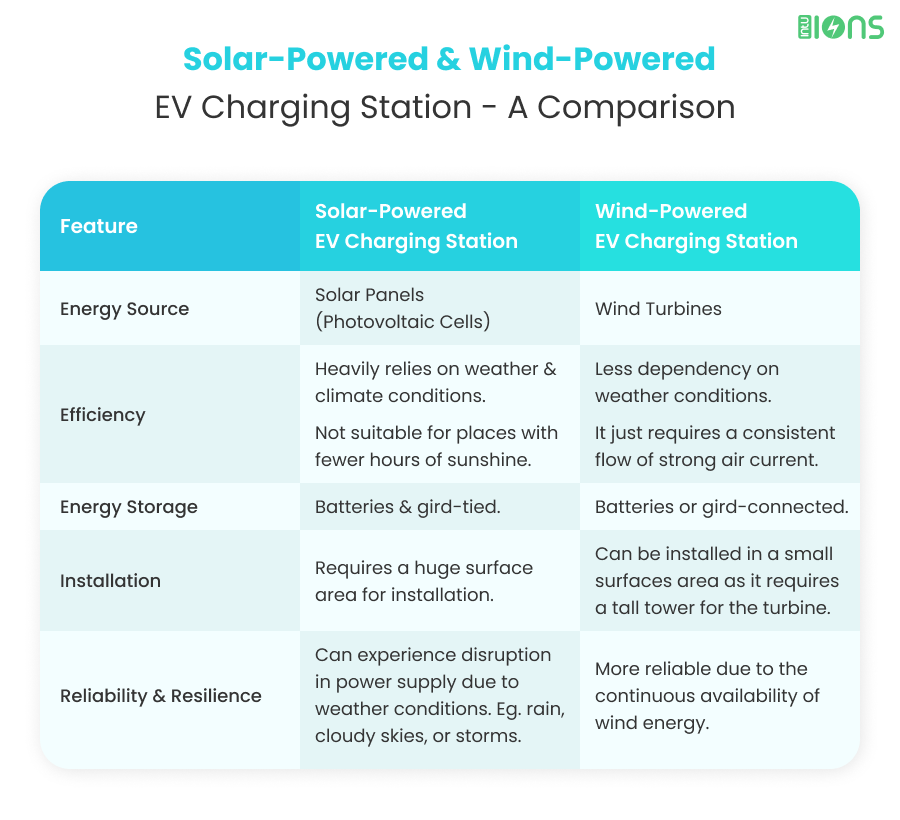
How Many Solar Panels Are Required to Charge an EV?
Unfortunately, this question doesn’t have a “one size fits all” answer – this depends on several factors like:
- Size of the vehicle’s battery
- The efficiency of the solar panel
- The capacity of the solar inverter
- Vehicle Model
However, it is observed that the average number of solar panels required to charge an EV is anywhere between 5 to 12 solar panels.
How Much Wind Energy is Required to Charge an EV?
Again, there is no right answer to this question – it depends on various factors like
- EV model
- Turbine size
- EV’s battery charging capacity
According to an estimate, an average EV requires 2500 kWh annually. A modern wind turbine can generate enough electricity to charge up to 4000 electric cars in a year.
How Much Time Is Needed For Solar Energy To Charge an Average EV?
The amount of time it takes to charge an average electric vehicle (EV) using solar energy depends on several factors:
- Solar panel’s power output
- Average sunshine hours
- Battery size
- Type of charger
An EV with a standard 120-volt outlet typically takes around 8- 16 hours to get fully charged. However, if upgraded to a level 2 EV charger, the time reduces by 50% – this type of charger usually needs 6-8 hours.
How Much Time Is Needed For Wind Energy To Charge an Average EV?
The amount of time it takes to charge an EV through a wind-powered charging station depends on a variety of factors such as:
- Size of the turbine
- Wind speed in the region
- EV Model
- Charging infrastructure.
An average electric vehicle needs around 20 kW to achieve 80% battery power and would take 6-8 hours to fully charge. When upgraded to a 230V/30A circuit, it would take somewhere between 3-4 hours.
These Renewable EV Charging Stations Are Revolutionizing the Transport Sector
- ElaadNL – Netherlands
ElaadNL, based in the Netherlands, use modern infrastructure, along with solar and wind energy for EV charging. They balance the energy demand of several charge points and leverage clean energy. In addition, they get real-time data about charging station uptime and notifications if something goes wrong.
- EVgo – 100% Renewable EV Charging Station, USA
EVgo is the largest public EV charging network in the USA and uses 100% renewable energy. EVgo has combined wind and solar energy to operate its 1100 fast chargers across 66 metropolitans in the USA.
- Wind & Solar Tower – Combination of Solar and Wind EV Charging Station
An American company developed a device that offers the combined power of solar and wind for EV charging station. This provides an excellent solution for EV charging at places where the electrical grid is not stable.
Known as Wind & Solar Tower, this system is 82 feet tall and occupies 21.5 square feet of the ground, and has around 6 charging points.
When not charging an EV, the energy generated by a wind turbine is stored in an on-site battery. Moreover, unused and excess energy is sent into the grid, thus making the grid more stable.
EVs Using Renewable Energy for Charging – A Comparison
With renewable energies becoming more mainstream, many EVs are adopting clean power to charge the batteries. Here’s a small study of comparison chart for more details:
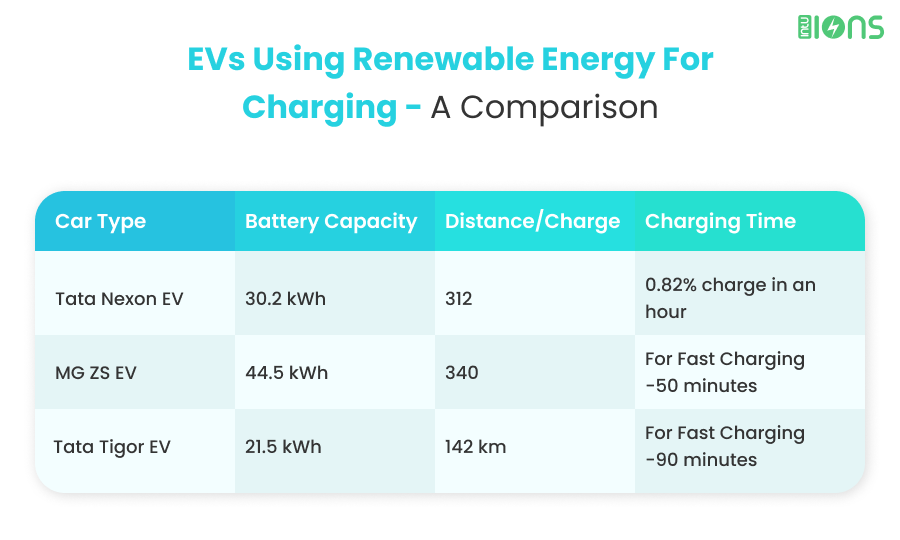
Takeaway
As the world continues to face the impact of carbon emissions and the greenhouse effect, it becomes increasingly important to switch to sustainable energies.
The electrification of transportation is a small step towards a greener and cleaner planet. However, it is also necessary to adopt renewable sources such as solar and wind to charge EVs to limit the use of fossil fuels.
If you have any queries about the Renewable Energy EV Charging Station, feel free to reach out to us.
